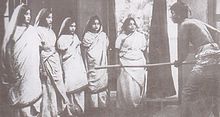New theaters
The New Theaters Limited was an Indian film company. During its existence from 1931 to 1955, it produced about 150 films. It was the most important Bengali film production facility and was one of the leading film companies of Indian film before India's independence .
history
The company owner and producer Birendra Nath Sircar had already founded International Filmcraft the year before with Charu Roy and Prafulla Roy . After only two silent films, he had a sound film studio built and equipped with a Tanar sound recording system. With the opening of the studio in the southern Kolkataer district of Tollygunge on February 10, 1931, the company was renamed "The New Theaters". Sircar had set himself the goal of appropriately realizing literary works on the screen , following the example of Madan Theater . This idea and the advanced equipment of the studio attracted numerous Bengali filmmakers. Directors Premankur Atorthy and Nitin Bose from Indian Kinema, actors Durgadas Bannerjee , Amar Mullick and Jiban Ganguly , from Barua Pictures Pramathesh Chandra Barua , Debaki Bose and Sushil Majumdar and from British Dominion Films Dhiren Ganguly came to New Theaters . In the ancillary work, the studio employed the writer Sailajananda Mukherjee , the composers Rai Chand Boral , Pankaj Mullick and Timir Baran , the blind singer Krishna Chandra Dey , and the sound engineer Mukul Bose .
New Theaters' first film was Dena Paona (1931) based on Sharatchandra Chattopadhyay 's novel of the same name, directed by Atorthy. After some moderately successful films, the breakthrough came with Debaki Boses Chandidas (1932), a holy film based on Aparesh Chandra Mukherjee's play from 1926. In the same year Natir Puja appeared , for which Rabindranath Thakur is directed. However, it is a filmed theatrical performance of the play in the New Empire Theater in Kolkata in honor of the author's 70th birthday, for which Nitin Bose was responsible for the video and his brother Mukul Bose for the sound recording. From 1933 onwards, New Theaters produced its films mostly in two language versions , one in Bengali and one in Hindi for the North and West Indian markets. For many all- Hindi films was Hemchandra Chunder responsible. While Debaki Bose and Premankur Atorthy often worked for other film companies from the mid-1930s, Nitin Bose and PC Barua shot the company's best-known productions, including Devdas (1935/36), Mukti (1937) and President (1937). Nitin Bose was also the director of Dhoop Chhaon / Bhagya Chakra at New Theaters in 1935 , the first Indian film to use the technique of playback singing . Well-known stars at New Theaters were the actors-singers Kundan Lal Saigal , Kanan Devi and Pahadi Sanyal . In addition to Saigal, the Hindi film actors Prithviraj Kapoor and Durga Khote also appeared several times in Hindi versions of New Theaters films.
At the beginning of the 1940s the importance of the West and South Indian market increased and New Theaters got into financial difficulties because the company had not built up its own sales structure but was dependent on professional film distributors. In addition, Nitin and Mukul Bose left the company in 1941. BN Sircar promoted new talents who had already worked in subordinate positions at New Theaters: In 1938 Phani Majumdar , previously assistant to PC Barua, made his directorial debut with Street Singer / Saathi ; In 1944 Nitin Bose's camera assistant Bimal Roy made his debut with Udayer Pathey ; from 1947 Kartick Chattopadhyay directed.
In 1955 New Theaters was closed. The studios in Tollygunge still function occasionally as a production facility for other Bengali film companies, although the outdated equipment is no longer suitable for film production.
Films (selection)
B = Bengali , H = Hindi , U = Urdu
|
|
Individual evidence
- ↑ New beginning for New Theaters? (February 11, 2007)
literature
- Pinaki Chakraborty: Chalachchitrer Itihase New Theaters, ISBN 81-7756-581-8
- Ashish Rajadhyaksha, Paul Willemen: Encyclopaedia of Indian Cinema , New Delhi 1999, p. 166

